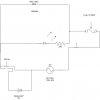Hi Guys! Once again I come back here, because I cannot handle a problem myself, not even a simple one. Ok, here is the story. I got one of those cheap little coffee mug warmers from Walmart to keep my coffee warm in the moring, but warm is a joke, more like lukewarm (yuk). So I went to the troble of taking it apart and looking at it to draw a schematic. I hope the one I made was accurate. (see attachment)
Any point, does anyone have any suggestions on how to make it hotter? I know that greater the resistance, greater the heat, but what is the best way to go about this. The wire that is heating the plate says 300v, 125C on itself (I am assuming maxium values?). Should I get a different wire? Boost the power somehow? One of the things that has me so confused is that since it draws it power from an AC plug, why is it only drawing less than a Amp? As you can see, I am not very bright at this yet. I would love to hear any suggestions.
Any point, does anyone have any suggestions on how to make it hotter? I know that greater the resistance, greater the heat, but what is the best way to go about this. The wire that is heating the plate says 300v, 125C on itself (I am assuming maxium values?). Should I get a different wire? Boost the power somehow? One of the things that has me so confused is that since it draws it power from an AC plug, why is it only drawing less than a Amp? As you can see, I am not very bright at this yet. I would love to hear any suggestions.

